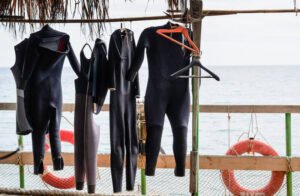When first wearing a wetsuit, you might wonder, “How tight should a wetsuit be?” It’s normal for it to feel stiff and restrictive at first. Over time and with repeated use, the wetsuit will gradually stretch and mold to your body shape. If you’re concerned about how to stretch a wetsuit to make it more comfortable, simply wearing it in water regularly can help it conform to your shape.
However, while a wetsuit is meant to fit tightly, it should never cause extreme discomfort. If your wetsuit is too tight, it may restrict movement or make breathing difficult. On the other hand, if it’s too loose, it won’t provide proper insulation or buoyancy.
Finding the right balance is key, especially when looking for the best wetsuit for women, beginners, kitesurfing or else: Ensuring that you have the comfort and performance needed for your water activities is as easy as it is important.
In this article, you will get answers to the following questions:
- Should a wetsuit be tight?
- How tight should a wetsuit be?
- How to tell if a wetsuit is too small?
- How to stretch a wetsuit?
Why a Proper Fitting Wetsuit is so Important
Wetsuit shopping can be quite stressful, not knowing that the initial fit of the wetsuit is not necessarily how it is going to fit through all its life. Is really the wetsuit too tight, too stiff, or does it have to be that way in order for your wetsuit to fit perfectly when in water?
The 5 Tasks of Your Wetsuit
People wear wetsuits to protect themselves from cold temperatures when surfing, diving, or swimming. They provide warmth, buoyancy, and compression during long stays in the sea.
All kinds of wetsuits, whether diving or swimming wetsuits, are designed to be worn close to the skin. Otherwise, all their advantages go out the window, like the warmth out of your body on a chilly day in the ocean.
Here is why it matters how tight should a wetsuit be:
1. Thermal Insulation
- A wetsuit works by trapping a thin layer of water between your skin and the suit, which your body warms up to provide insulation.
- If the wetsuit is too loose, water will flush in and out, reducing its ability to retain warmth.
- A snug fit ensures that the water stays in place, keeping you warm even in colder temperatures.
2. Mobility and Comfort
- A properly fitting wetsuit should allow a full range of motion without excessive restriction.
- If the suit is too tight, it can cause discomfort, hinder breathing, and limit your movement, affecting your performance.
- If it’s too loose, it can cause chafing or create drag in the water, making it harder to swim or manoeuvre.
3. Buoyancy
- Wetsuits provide additional buoyancy, helping swimmers stay afloat more easily.
- A suit that fits well enhances buoyancy evenly across your body, improving stability and confidence in the water.
4. Protection
- A well-fitting wetsuit shields your skin from harmful UV rays, abrasions, jellyfish stings, or other irritants in the water.
- Loose suits may leave areas exposed, reducing their protective effectiveness.
5. Efficiency and Safety
- For activities like diving, a poor fit can lead to fatigue due to increased drag or cold exposure, potentially creating safety concerns.
- For surfers, a snug wetsuit ensures better performance by staying in place during intense movements.
What Happens if: Wetsuit Too Tight
Wearing a wetsuit too tight can turn your aquatic adventure into an uncomfortable experience—and might even pose safety concerns. While the best surfing wetsuits are meant to fit snugly, like a second skin, an overly tight wetsuit can create more problems than benefits.
First, a too-tight wetsuit can restrict your movement, making it harder to paddle, swim, or manoeuvre in the water. This stiffness can leave you feeling awkward and less in control, which is the last thing you want during a dive or a surfing session.
Breathing might also feel constricted, especially if the wetsuit is compressing your chest. That can make it difficult to relax and enjoy your time in the water—or worse, lead to panic in challenging situations.
Beyond comfort, circulation is another concern. A wetsuit that’s excessively tight can pinch or compress your body in ways that reduce blood flow, leading to numbness or tingling in your limbs.
This not only affects your performance but can also compromise your safety, especially in colder water where circulation is key to staying warm.
On top of that, if too tight, to break into a wetsuit is a chore, often requiring an exhausting wrestling match before and after your session. Over time, this can strain the seams of your diving wetsuit, reducing its lifespan.
How to Tell if a Wetsuit is too Small
A wetsuit that is too small will feel uncomfortably tight and may restrict your movement, making activities like swimming or surfing difficult. You may also experience trouble zipping up the suit, especially around the chest or shoulders.
If the wetsuit digs into your skin or causes discomfort, it’s likely too small. Pay attention to areas like the neck, wrists, and ankles — if you feel pinching or constriction, it’s a sign the wetsuit is too tight.
Additionally, if the wetsuit causes any bunching or leaves noticeable gaps, it’s not providing a proper fit. A wetsuit should fit snugly to maintain warmth and buoyancy but still allow for flexibility and comfort.
Wetsuit Shopping — Are Wetsuits Supposed to Be Tight?
Finding the perfect wetsuit can feel overwhelming, especially with so many sizes, styles, and features to consider. One of the most common questions is, “Are wetsuits supposed to be tight?” The short answer is yes—but there’s a balance to strike between snugness and comfort.
1. Finding the Right Wetsuit Size
A wetsuit is designed to fit close to your skin to trap a thin layer of water, which your body warms to keep you insulated. If it’s too loose, water will constantly flow through, making it ineffective in maintaining warmth.
However, a wetsuit that’s too tight can restrict your movement or breathing, leaving you uncomfortable and fatigued.
So: How to choose the right wetsuit size?
- Torso and Length: The suit should align with your body proportions without bunching or sagging.
- Range of Motion: Try bending your knees, rotating your arms, or mimicking swimming motions. If you feel restricted, it might be too small.
- Neck Fit: Ensure the neck seal is snug enough to keep water out but doesn’t feel like it’s choking you.
To get a more detailed idea of how the measurements of your perfect wetsuit are, a wetsuit size chart can tell you exactly which size of wetsuit would be your best choice.
2. Finding the Right Wetsuit Thickness
Body measurements, temperature tolerance, and the location where you’ll be using your wetsuit all influence how thick your wetsuit needs to be to provide warmth, buoyancy, and the right balance of mobility.
The classic stereotype that women are always colder than men might not be entirely accurate, but women’s surfsuits still differ in certain aspects, such as how the wetsuit thickness is distributed across the suit.
So: How Tight Should a Wetsuit Be?
When trying on a wetsuit:
- It should feel like a second skin, hugging your body without pinching or cutting off circulation.
- Expect a slight restriction in movement, especially if it’s new, as most wetsuits stretch slightly over time.
- Check the fit around critical areas: the neck, wrists, and ankles should be snug to prevent water from flushing in, but not so tight that they feel painful.
While our wetsuit size chart helps you find the right fit, our wetsuit thickness guide can explain how to balance warmth and freedom of movement, making it easy to choose the perfect wetsuit for your needs.
3. Try it on: How to Break into a Wetsuit
You figured out all the important measurements, picked a suit, and it’s time to try it on? Unfortunately, easier said than done. Trying on your wetsuit in a shop is not at all the same experience as you will have, wearing it in the water.
If you’ve closely followed the guidelines for selecting the right size and thickness, yet the wetsuit still doesn’t feel perfect when you put it on for the first time, it could be due to one of the following 5 reasons:
- Wear It Regularly
- A new wetsuit might feel stiff or tight at first. The neoprene will gradually soften and mould to your body after a few uses, becoming more comfortable.
- Use Lubricant for Easy Entry
- Apply a wetsuit-safe lubricant or wear a rash guard to make putting it on and taking it off easier, especially if it feels overly tight initially.
- Get it Wet
- Wearing your wetsuit in water helps it adapt more quickly to your shape. Take a short swim or soak it before your first full session.
- Avoid Overstretching
- While it’s tempting to tug hard on a tight wetsuit, overstretching can damage the neoprene. Use care when putting it on or off, and always pull gently along the seams.
- Practice Patience
- Breaking into a wetsuit takes time. Give it a few wears to fully adjust before deciding if it’s the right fit.
How to Adjust Your Wetsuit
Getting your wetsuit to fit comfortably is key for both comfort and performance. Here’s how to adjust it:
- Check the Fit: Your wetsuit should feel snug but not uncomfortable. Make sure the neck, wrists, and ankles are sealed to prevent water from rushing in.
- Position It Right: Pull the suit up evenly and ensure it fits smoothly against your body. Adjust the seams around your shoulders and torso for a clean fit.
- Use Lubricant: If you find it difficult to get into the wetsuit, a little wetsuit-safe lubricant or a rash guard can help make the process easier.
Do Wetsuits Stretch Over Time: Wetsuit vs. Drysuit
Both wetsuits vs. drysuits keep you warm and protected, but they work in different ways:
- Wetsuit: A wetsuit lets water in, creating a thin layer of water between your skin and the suit. Your body warms this water to keep you warm. Wetsuits are perfect for warmer waters and active sports like surfing.
- Drysuit: A drysuit keeps water completely out, using layers of insulation underneath to keep you warm. It’s ideal for colder waters and activities like diving, where extra insulation is needed.
As for the question ‘Do wetsuits stretch over time?’: Yes, wetsuits do stretch a little over time. The neoprene material naturally adjusts to your body shape with repeated use.
After wearing it a few times, you may find it becomes more comfortable, especially around areas like the shoulders and knees. However, it’s important to choose the right size from the start, as the wetsuit won’t stretch excessively.
Drysuits on the other hand generally do not stretch out over time in the same way wetsuits do. Unlike wetsuits, which are made from stretchable neoprene, drysuits are often constructed from materials like nylon, trilaminate, or other non-stretch fabrics. These materials are designed to provide a durable and watertight seal, not flexibility or stretch.
While drysuits don’t stretch, they can adapt slightly over time as the inner lining may soften with use, especially in the case of neoprene drysuits. However, any noticeable stretching is minimal compared to wetsuits. If a drysuit feels too tight or uncomfortable initially, it is likely due to an improper fit rather than something that will improve over time.
Can You Stretch a Wetsuit?
While wetsuits do stretch a little over time with regular use, it’s essential not to try to intentionally stretch them too much. The neoprene material is designed to fit snugly against your body to trap a thin layer of water, which keeps you warm, and stretching it too much could compromise its performance and longevity.
For those who need a little extra room, some wetsuit-specific stretching products can gently loosen the material without damaging it. These products are designed to help the neoprene stretch a little in areas like the shoulders or chest, providing a more comfortable fit.
However, it’s essential to be cautious putting on and knowing how to wash a wetsuit properly, and avoid overstretching the material, as doing so can weaken the suit and reduce its insulating properties.
Do Wetsuits Loosen in Water?
Wetsuits don’t actually loosen once you’re in the water, but they do tend to feel more comfortable. This is because the neoprene material softens slightly when wet, allowing it to mould more closely to your body over time.
The thin layer of water that gets trapped inside the suit between your skin and the wetsuit also warms up as your body heats it, helping to create a comfortable insulating barrier. This layer of warm water contributes to the feeling of comfort, as it keeps you warm without the suit feeling overly tight.
However, it’s important to note that if your wetsuit is too tight when you first put it on, it will still feel restrictive in the water. Wetsuits are designed to be snug, but they should never cause pain or significantly restrict movement. If you feel uncomfortable or unable to move freely, it’s a sign that the wetsuit might not be the right size.
Conclusion: How to Break in a Wetsuit Without Breaking a Sweat
After all, finding the perfect wetsuit fit is essential for a comfortable and enjoyable experience—not just when you’re in the water, but also making the process of putting it on more pleasant. It should be snug enough to keep you warm and flexible, but not so tight that you feel like you’re trapped in a human-sized sausage casing! After all, not even the best surfboard for beginners will save your lesson if you feel restricted and clammed up in your wetsuit. So, take the time to find that perfect fit – only then will you be able to fully enjoy the waves and move freely.
FAQ – Most asked questions
A wetsuit that is too small will feel uncomfortably tight, restricting your movement and making it difficult to breathe. If you find it hard to zip up the suit or if it causes discomfort in certain areas, such as the chest or shoulders, it may be too small. Additionally, if you experience any pinching around the neck, wrists, or ankles, or if you notice that the wetsuit bunches up or leaves gaps, it’s likely not the right size for you.
Wetsuits don’t loosen significantly in water, but they can feel more comfortable as the neoprene softens and moulds to your body.
Breaking into a wetsuit means getting used to the fit and comfort of the suit as it adapts to your body. Here’s how to make the process easier:
1. Choose the Right Size: A wetsuit should be snug but not uncomfortable. Make sure you’re wearing the correct size for your body.
2. Wear It Regularly: The more you wear your wetsuit, the more it will stretch and mold to your body.
3. Use Lubrication: If you’re having trouble putting it on, use a wetsuit lubricant or baby powder to reduce friction.
4. Give It Time: Like any new gear, the wetsuit will become more comfortable after a few uses, as the neoprene stretches and softens.
Yes, a wetsuit should be snug around the neck, wrists, and ankles to prevent water from entering. However, it should never feel uncomfortable or cause pinching. The fit around these areas should create a seal, which helps maintain warmth by trapping a small layer of water between your skin and the suit.









